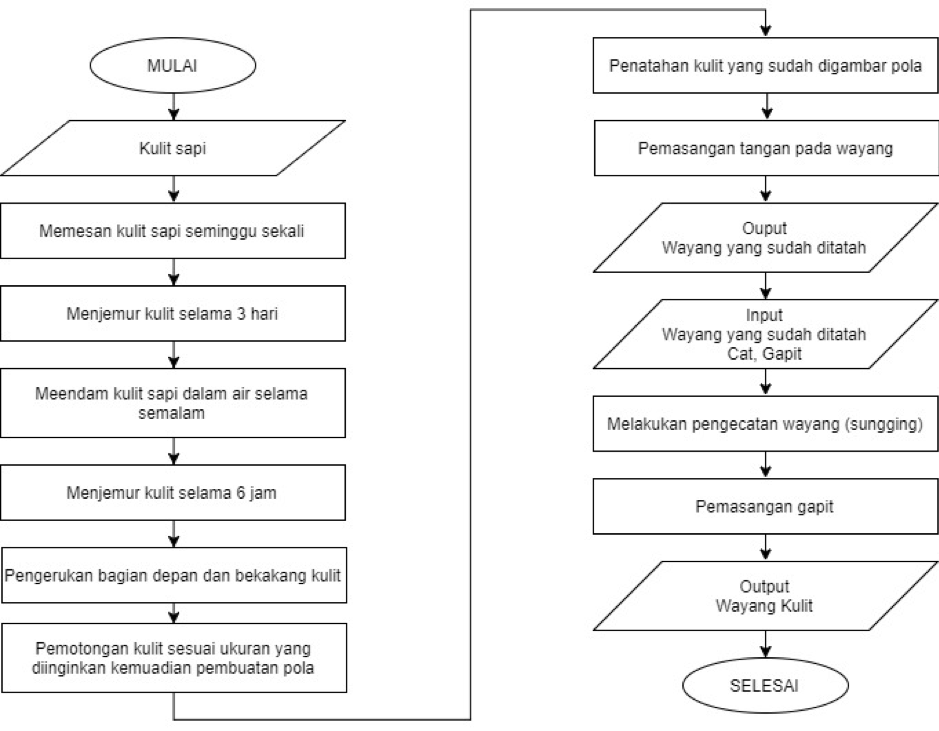written by: Intan
Yogyakarta is one of cities in Indonesia, which has many traditional cultures and arts. In this city, we can found some of small and medium industries where produce traditional product, such as batic, traditional puppet, rattan bag, traditional toy, souvenir, etc. In Bantul there is a region, named Imogiri where become a central of traditional puppet production. If we visit Imogiri, we can see many home production there.
“Desa Wisata Pucung Rejo” is one of small industry located in Imogiri. This industry belong to Bapak Mugiman. Bapak Mugiman leads some small industries in Imogiri, which are making traditional puppet. On a week, one industry can produce about 50 traditional puppets. Then, all of the puppets gathered to Bapak Mugiman’s industry.
Author did some observations to the small industry that belong to Bapak Wakijan. Author was observed the production process of making traditional puppet. Author also did interview with Bapak Wakijan to find out what is the problem that happened in his industry. Bapak Wakijan said that his industry has limited resources, so sometimes he cannot fulfilled demand from customers. Based on that problem, author tried to analyze the system in order to propose some improvements that could increase productivity in that industry.
One of method to understand the behavior of system is by modelling the system with simulation. The production system of traditional puppet is simulated by software named FlexSim. Before doing simulation, author needs some data, then the data will use to build the model in FlexSim. The production flow of traditional puppet can be seen in Figure 1.

Figure 1. Production Flow of Traditional Puppet
After understanding the production flow of traditional puppet, the next step is write down the time of each process. Then, do some calculations to the time of each process and find the time distribution to be use into FlexSim. The time distribution and processing time of each process in making traditional puppet can be seen in Table 1.
Table 1. Time Distribution and Processing Time of Each Process in Making Traditional Puppet

Production layout of making traditional puppet should be made, so the model in FlexSim can representate the real system correctly. The layout consists of the real size and the distance between the workstation. Production layout in Bapak Wakijan’s industry can be seen in Figure 2.

Figure 2. Production Layout in Bapak Wakijan’s Industry
After collecting of all of the data, the model on FlexSim can be made. Then, model will be through verification and validation step to ensure that the model representate the real system correctly. Model is running during 7 days to count how much the output of the system. Model can be analyzed further using Dashboard and Report Statistics feature in FlexSim. Author was analyzed the utility of five employees. Author found that the utility between one employee to other is not equal. The diagram which show utility of five employees can be seen in Figure 3.

Figure 3. The Existing Utility of Five Employees
Based on Figure 3. We can see that the utility of three employees is around 77%, one employee is 54%, and the other one is just 0.01%. So, the conclusion is the utility between employee in that industry is not equal.
Author proposed 3 alternative solutions that can optimize the system. The first solution is add a hair dryer machine to decrease the time of drying leather. The second alternative is to change the amount of employee in painting station, from 3 employees to 2 employees. Then, give more tasks to the employee who has the lowest utility to work in painting station. The third alternative is increase arrival time of leather, from once a week to twice a week. Then, add one cutting station and one hand installation station.
After implementing all of the alternatives into model that author made before, the optimal result is the implementation of the third alternative, in terms of the utility of employee and the productivity of the system. The utility of the employee is become more equal, that is around 82 until 99%. The productivity of the system is increasing 120%, from producing 50 puppets in a week to 110 puppets in a week. The utility of the employee after implementing the improvement to the system can be seen in Figure 4.

Figure 4. Utility of The Employee After Improving The System
Then, the productivity of traditional puppet in a week can be seen in Figure 5.

Figure 5. Productivity of Traditional Puppet in A Week
So, the best alternative which can be implemented in Bapak Wakijan’s industry is the third alternative. Based on the cost analysis done by author, value of B/C ratio if implementing the third solution is 1.16, that means its solution is feasible to implement in that industry.
Simulation can be one of the effective way to understand the behavior of the system, analyzing the system, and doing some improvements to the system without changing the system and spending large cost.
